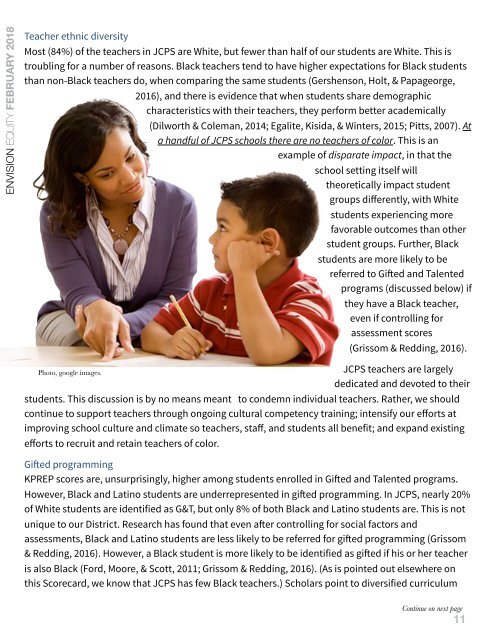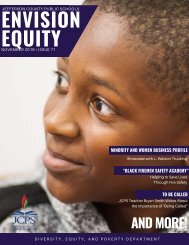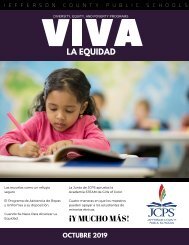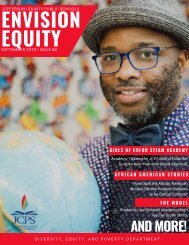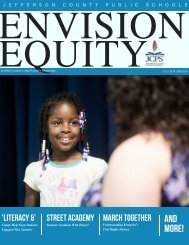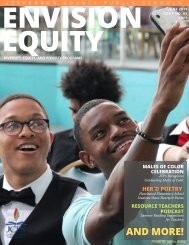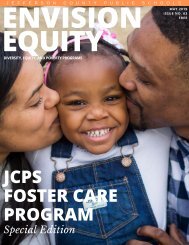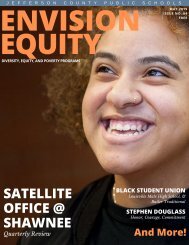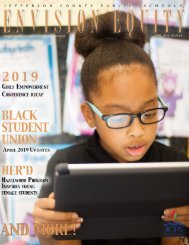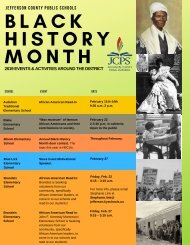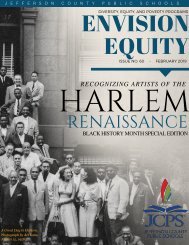February 2018 Edition of Envision Equity
You also want an ePaper? Increase the reach of your titles
YUMPU automatically turns print PDFs into web optimized ePapers that Google loves.
ENVISION EQUITY FEBRUARY <strong>2018</strong><br />
Teacher ethnic diversity<br />
Most (84%) <strong>of</strong> the teachers in JCPS are White, but fewer than half <strong>of</strong> our students are White. This is<br />
troubling for a number <strong>of</strong> reasons. Black teachers tend to have higher expectations for Black students<br />
than non-Black teachers do, when comparing the same students (Gershenson, Holt, & Papageorge,<br />
2016), and there is evidence that when students share demographic<br />
characteristics with their teachers, they perform better academically<br />
(Dilworth & Coleman, 2014; Egalite, Kisida, & Winters, 2015; Pitts, 2007). At<br />
a handful <strong>of</strong> JCPS schools there are no teachers <strong>of</strong> color. This is an<br />
example <strong>of</strong> disparate impact, in that the<br />
school setting itself will<br />
theoretically impact student<br />
groups differently, with White<br />
students experiencing more<br />
favorable outcomes than other<br />
student groups. Further, Black<br />
students are more likely to be<br />
referred to Gifted and Talented<br />
programs (discussed below) if<br />
they have a Black teacher,<br />
even if controlling for<br />
assessment scores<br />
(Grissom & Redding, 2016).<br />
Photo, google images.<br />
JCPS teachers are largely<br />
dedicated and devoted to their<br />
students. This discussion is by no means meant to condemn individual teachers. Rather, we should<br />
continue to support teachers through ongoing cultural competency training; intensify our efforts at<br />
improving school culture and climate so teachers, staff, and students all benefit; and expand existing<br />
efforts to recruit and retain teachers <strong>of</strong> color.<br />
Gifted programming<br />
KPREP scores are, unsurprisingly, higher among students enrolled in Gifted and Talented programs.<br />
However, Black and Latino students are underrepresented in gifted programming. In JCPS, nearly 20%<br />
<strong>of</strong> White students are identified as G&T, but only 8% <strong>of</strong> both Black and Latino students are. This is not<br />
unique to our District. Research has found that even after controlling for social factors and<br />
assessments, Black and Latino students are less likely to be referred for gifted programming (Grissom<br />
& Redding, 2016). However, a Black student is more likely to be identified as gifted if his or her teacher<br />
is also Black (Ford, Moore, & Scott, 2011; Grissom & Redding, 2016). (As is pointed out elsewhere on<br />
this Scorecard, we know that JCPS has few Black teachers.) Scholars point to diversified curriculum<br />
Continue on next page<br />
11


